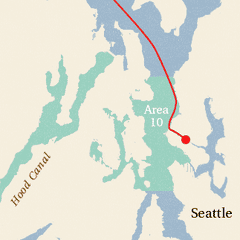Loki Fish Is shipping perishable items again! Rejoice and visit our webstore to make an order. Our shipping schedule is now once weekly!
Southeast Alaska Fishery
 The majority of Loki fishing in southeast Alaska is done along a 10-mile stretch of beach in Clarence Strait, a biologically rich and diverse area due to a large amount of tidal mixing. Pete has fished these same stocks of salmon for over 35 years. Although the market for his catch has changed and evolved with the business, careful fisheries management has ensured that the salmon are able to return in strong numbers each year. Our Southeast Alaska fishery is certified sustainable by the Marine Stewardship Council.
The majority of Loki fishing in southeast Alaska is done along a 10-mile stretch of beach in Clarence Strait, a biologically rich and diverse area due to a large amount of tidal mixing. Pete has fished these same stocks of salmon for over 35 years. Although the market for his catch has changed and evolved with the business, careful fisheries management has ensured that the salmon are able to return in strong numbers each year. Our Southeast Alaska fishery is certified sustainable by the Marine Stewardship Council.
For larger maps of our fishing grounds, click on the map or on one of the following links: Inside passage, Puget Sound or Southeast Alaska.
Puget Sound Fishery
 Each fall, a healthy run of Keta salmon run back through Puget Sound. This species of wild salmon head out to the ocean after spending just three to four months as smolts in their native stream. Once at sea, they grow to maturity before returning to their home streams via Puget Sound to spawn. We fish Puget Sound Keta for a three to four week season from mid-October to mid-November. Every other year, we fish for Pink salmon in September in Puget Sound. Pinks run in odd years in Washington, and even years in most areas of Alaska. In our main fishing area in Southeast Alaska, intersecting runs allow us the opportunity to catch pinks every year.
Each fall, a healthy run of Keta salmon run back through Puget Sound. This species of wild salmon head out to the ocean after spending just three to four months as smolts in their native stream. Once at sea, they grow to maturity before returning to their home streams via Puget Sound to spawn. We fish Puget Sound Keta for a three to four week season from mid-October to mid-November. Every other year, we fish for Pink salmon in September in Puget Sound. Pinks run in odd years in Washington, and even years in most areas of Alaska. In our main fishing area in Southeast Alaska, intersecting runs allow us the opportunity to catch pinks every year.
Loki Fish Co.’s main fishing area in Puget Sound is in Area 10 just off of Elliot Bay. We also occasionaly fish in Hood Canal and farther north around the Snohomish and Skagit river systems.